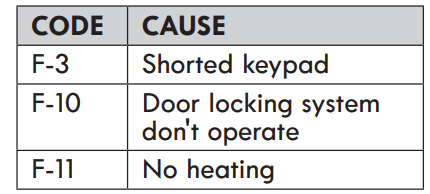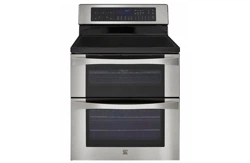Documents: Go to download!
- Owner's manual - (English, Spanish)
- OVERVIEW
- FEATURES
- USING THE COOKTOP
- USING THE OVEN
- Convection Bake
- CARE AND CLEANING
- TROUBLESHOOTING
- FAQs
Table of contents
Owners' Guide Ranges
OVERVIEW
Parts
Make sure to understand the name and function of each part. Throughout this manual, the features and appearance may vary depending on your model.
NOTE: The model and serial number can be verified at rating label.

Control Panel

NOTE: Cooktop Element Controls are set up in the same order as the corresponding elements.
HS (Hot Surface) Indicator
The HS indicator will appear in the display once the element is turned off or during the self-clean cycle. The HS indicator will stay on until the surface has cooled to approximately 150˚F/66˚C or when the self-clean cycle ends.
Flashing Time
If the oven displays a flashing clock, press the Clock button and reset the time, or press any button to stop the flashing.
FEATURES
Clock
The clock must be set to the correct time of day in order for the automatic oven timing functions to work properly.
- Press CLOCK.
- Press the number buttons to enter the time. For example, to set the clock for 10:30, press the numbers: 1, 0, 3 and 0.
- Press START.
NOTE:
- The time of day cannot be changed during a Timed Baking or Self Clean cycle.
- To check the time of day when the display is showing other information, press the CLOCK button.
- If no buttons are pressed within 25 seconds of pressing the CLOCK button, the display will revert to the original setting.
- If the display time is blinking, you may have experienced a power failure. Reset the time.
Setting the Hour Mode on the Clock (12 or 24 hours)
The range defaults to a 12-hour clock. You can reset the clock to a 24-hour clock.
- Press and hold the CLOCK button for three seconds.
- Press the 1 button for 12-hour or the 2 button for 24-hour.
- Press the START button to accept.
Minimum and Maximum Default Settings
All of the features listed have a minimum and a maximum time or temperature setting that may be entered. An entry acceptance beep will sound each time a button is pressed.
An entry error tone (two short tones) will sound if the entry of the temperature or time is below the minimum or above the maximum setting for the feature.
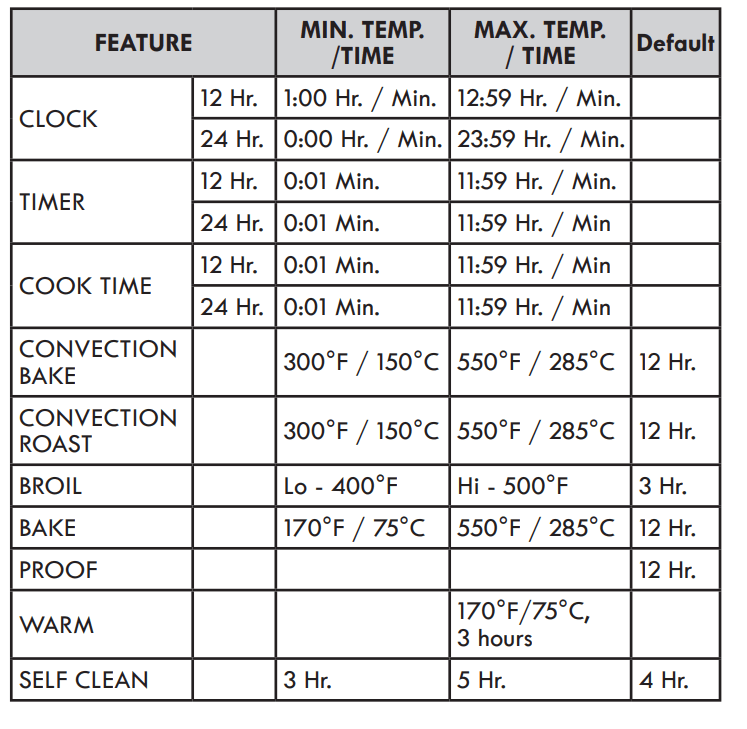
Timer On/Off
The UPPER or LOWER TIMER ON/OFF serves as an extra timer in the kitchen that will beep when the set time has run out. It does not start or stop cooking. The UPPER or LOWER TIMER ON/OFF feature can be used during any of the other oven control functions. The UPPER and LOWER TIMER can be operated independently of each other.
To set the Timer (for example to set 5 minutes):
- Press UPPER TIMER ON/OFF or LOWER TIMER ON/OFF twice. 0:00 will appear and TIMER will flash in the display.
- Press 5. 0:05 will appear in the display.
- Press UPPER TIMER ON/OFF or LOWER TIMER ON/OFF to start the timer. The remaining time countdown will appear in the display.
NOTE: If UPPER TIMER ON/OFF or LOWER TIMER ON/OFF is not pressed, the timer will return to the time of day. - When the set time has run out, End will show in the display. The indicator tones will sound every 15 seconds until UPPER TIMER ON/OFF or LOWER TIMER ON/OFF is pressed.
NOTE:
- If the remaining time is not in the display, recall the remaining time by pressing UPPER TIMER ON/OFF or LOWER TIMER ON/OFF.
- Press UPPER TIMER ON/OFF or LOWER TIMER ON/ OFF once to set the time in minutes and seconds.
- Press UPPER TIMER ON/OFF or LOWER TIMER ON/ OFF twice to set the time in hours and minutes.
Canceling the Timer
- Press UPPER TIMER ON/OFF or LOWER TIMER ON/OFF once. The display will return to the time of day
Settings
Press the SETTINGS button repeatedly to toggle through and change oven settings. The SETTINGS button allows you to:
- Turn convection auto conversion on/off
- Adjust the oven temperature
- Set the language
- Set the preheating alarm light on/off
- Set the beeper volume
- Switch the temperature scale between Fahrenheit and Celsius
Convection Auto Conversion
When cooking using a convection cycle (Conv. Bake and Conv. Roast), the oven temperature is automatically reduced by 25 °F (14 °C). The display will show the changed temperature. This feature is called Convection Auto Conversion. The range comes with this feature enabled.
Changing the Convection Auto Conversion Setting
- Press SETTINGS once or until Auto appears in the display.
- Press 1 to enable or 2 to disable the function.
- Press START to accept the change.
Oven Temperature Adjustment
You may find that your new oven cooks differently than the one it replaced. Use your new oven for a few weeks to become more familiar with it before changing the temperature settings. If after familiarizing yourself with the new oven, you still think that it is too hot or too cold, you can adjust the oven temperature yourself.
Adjusting the Oven Temperature
- Press SETTINGS repeatedly until L-AJ (lower oven) or U-AJ (upper oven) appears in the display
- Use the number buttons to enter the number of degrees you want to adjust the oven temperature.
- Increase or decrease the temperature by pressing Settings to toggle between increase (+) or decrease (-).
- Press START to accept the change.
NOTE:
- This adjustment will not affect the broiling or Self Clean temperatures. The adjustment will be retained in memory after a power failure. The oven temperature can be increased (+) or decreased (-) as much as 35°F or 19°C.
- Once the temperature is increased or decreased, the display will show the adjusted temperature until it is readjusted.
Language
The default language of the display is English. It can be changed to Spanish or French.
- Press SETTINGS repeatedly until Lng appears in the display. Press 1 for English, 2 for Spanish, or 3 for French.
- Press START to accept the change.
Preheating Alarm Light
When the oven reaches its set-temperature, the preheating alarm light will flash until the oven door is opened.
Changing the Preheating Alarm Light Setting
- Press SETTINGS repeatedly until PrE appears in the display.
- Press 1 for ON or 2 for OFF.
- Press START to accept the change.
Beeper Volume
- Press SETTINGS repeatedly until BEEP appears in the display.
- Press 1 for LOUD, 2 for NORMAL, 3 for LOW, and 4 for MUTE.
- Press START to accept the change.
Fahrenheit or Celsius
The oven temperature settings can either be set to Fahrenheit or Celsius. The oven defaults to Fahrenheit unless changed by the user.
- Press SETTINGS repeatedly until Unit appears in the display.
- Press 1 for F (Fahrenheit) or 2 for C (Celsius).
- Press START to accept the change.
Oven Light
The interior oven light automatically turns ON when the door is opened. The oven light may also be manually turned ON or OFF by pressing the upper or lower  button.
button.
NOTE: The oven light cannot be turned on if the Self Clean function is active.
Lockout
The Lockout feature automatically locks the oven door and prevents most oven and cooktop controls from being turned on. It does not disable the clock, timer or the interior oven light.
- Press and hold the START button for three seconds.
- The lock melody will sound, OVEN LOCKOUT or LOC will appear in the display and the lock Icon
 will flash in the display.
will flash in the display. - Once the oven door is locked, the lock Icon
 indicator will stop flashing and remain on.
indicator will stop flashing and remain on. - To deactivate the Lockout feature, press and hold the START button for three seconds. The unlock melody will sound and the door and the controls will be unlocked.
Delay Start (Delayed Timed Cook)
The automatic timer of the DELAYED TIMED COOK function will turn the oven ON and OFF at the time you select. This feature can only be used with the: BAKE, CONVECTION BAKE and CONVECTION ROAST modes.
Setting the Oven for Delayed Start (for example, to BAKE at 300°F and start operating the bake mode at 4:30):
Make sure that the clock is set for the correct time of day.
- Press BAKE. 350°F will appear in the display.
- Use the number buttons to set the temperature: Press 3, 0 and 0.
- Press DELAY START.
- Set the start time: Press 4, 3 and 0 for 4:30.
- Press START. A short beep will sound and the oven will begin baking.
NOTE:
- To cancel the DELAYED TIMED COOK function, press the STOP button at any time.
- To change the cooking time, repeat steps 3-4 and press the START button.
- If your oven clock is set as a 12 hour clock, you can delay the cook time for 12 hours. If your oven clock is set as a 24 hour clock, you can delay the cook time for 24 hours.
The oven will continue to cook for the set amount of time and then turn off automatically. When the cooking time has elapsed:
- END and the time of day will show in the display.
- The cook end indicator tone will sound every 60 seconds until the STOP button is pressed.
- When WARM is set, the warming function is activated after cooking for the set time.
CAUTION:
- Use the automatic timer when cooking cured or frozen meats and most fruits and vegetables. Foods that can easily spoil, such as milk, eggs, fish, meat or poultry, should be chilled in the refrigerator. Even when chilled, they should not stand in the oven for more than 1 hour before cooking begins, and should be removed promptly when cooking is completed.
- Eating spoiled food can result in sickness from food poisoning.
Cook Time (Timed Cook)
The TIMED COOK feature allows you to set the oven to cook for a specific length of time. This feature can only be used with the BAKE, CONVECTION BAKE and CONVECTION ROAST modes.
Setting the TIMED COOK function (for example, BAKE at 300°F for 30 minutes):
Make sure that the clock is set to the correct time of day.
- Press BAKE. 350°F will appear in the display.
- Use the number buttons to set the temperature. Press 3, 0 and 0.
- Press COOK TIME. TIMED will flash, and BAKE, 0:00 and 300°F will appear in the display.
- Set the baking time: Press 3 and 0 (for 30 minutes). The baking time can be set for any amount of time between 1 minute and 11 hours and 59 minutes.
- Press START. The display will show the cooking time countdown.
NOTE: To start the WARM function at the end of the timed cook cycle, repeat steps 1-4 and then press the WARM button. WARM will appear in the display. (Refer to the "WARM" section on the 27 page.)
The oven will continue to cook for the set amount of time and then turn off automatically. When the cooking time has elapsed:
- END and the time of day will show in the display.
- The cook end indicator tone will sound every 60 seconds until the STOP button is pressed.
- When WARM is set, the warming function is activated after cooking for the set time.
Changing the Cook Time while Cooking (for example, to change the cook time from 30 minutes to 1 hour and 30 minutes):
- Press COOK TIME.
- Press the number keys to change the baking time: 1, 3, 0.
- Press START to accept the change.
USING THE COOKTOP
Cooking Areas
The cooking areas on the range are identified by permanent circles on the glass cooktop surface. For the most efficient cooking, fit the pan size to the element size.
Pans should not extend more than 1/2 to 1-inch beyond the cooking area.
When a control is turned on, a glow can be seen through the glass cooktop surface. The element will cycle on and off to maintain the preset heat setting, even on Hi.

CAUTION:
- Only use cookware and dishes that are safe for oven and cooktop use.
- Always use oven mitts when removing food from the cooktop and oven.
- Do not place sealed containers on the cooktop.
- Do not use plastic wrap to cover food while on the cooktop. Plastic may melt onto the surface and be very difficult to remove.
- Never leave food on the cooktop unattended. Spillovers can cause smoke. Greasy spillovers may catch on fire.
- The surface element may appear to have cooled after it has been turned off. The element may still be hot and touching the element before it has cooled sufficiently can cause burns.
Hot Surface Indicator
HS (Hot Surface) will appear in the display once the element is turned off or during the self-clean cycle. The HS indicator will stay on until the surface has cooled to approximately 150°F (66°C) or when the self-clean cycle ends.
CAUTION:
- It is normal for the surface elements to cycle on and off during cooking, even at higher settings. This will happen more frequently if cooking on a lower temperature setting.
Using the Cooktop Elements
Turning On a Single Element
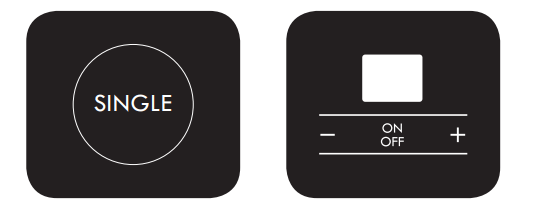
- Press the ON/OFF button that controls the desired element.
- Press the + button once to adjust the element temperature to Hi, or the – button once to adjust the element temperature to Lo.
- Use the – / + buttons to adjust the element's temperature settings. The element's temperature settings are adjustable at all times.
- To turn off the element after cooking, press the ON/ OFF button once.
NOTE:
- Hi is the highest temperature available.
- Lo is the lowest temperature available.
- Press and hold the + or – buttons to quickly scroll through the temperature settings.
Turning On a Dual Element
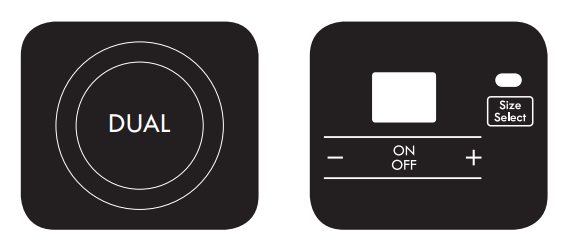
Use the dual element as a dual or single element based on the size of the cookware being used.

- Press the ON/OFF button that controls the dual element.
- Press the Size Select button to select either the inner (smaller) or outer (larger) element function. The dual element defaults to the inner element function. The light bars above the Size Select button indicate whether the element is adjusted for the inner or outer element function. One bar will display for the inner element and two bars will display for the outer element.
- Press the + button once to adjust the element's temperature to Hi, or the – button once to adjust the element's temperature to Lo.
- Use the – / + buttons to adjust the element's temperature settings. The element's temperature settings are adjustable at all times.
- To turn off the element after cooking, press the ON/ OFF button once.
NOTE:
- Hi is the highest temperature available.
- Lo is the lowest temperature available.
- Press and hold the + or – buttons to quickly scroll through the temperature settings.
CAUTION:
- NEVER leave food on the cooktop unattended. Spillovers can cause smoke. Greasy spillovers may catch on fire.
- The oven surface element may appear to have cooled after it has been turned OFF. The element may still be hot and you could be burned if you touch the element before it has cooled sufficiently
Turning On a Triple Element
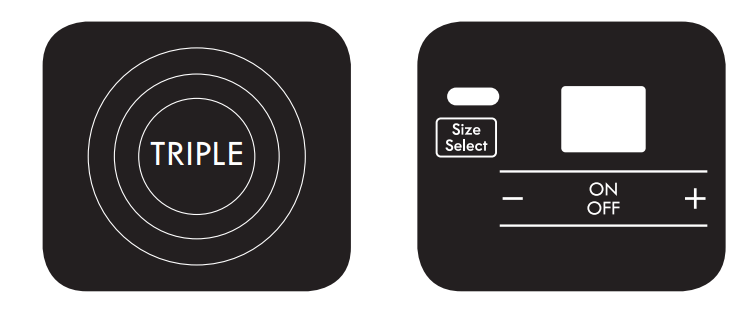
Use the triple element as a single, dual, or triple element based on the size of the cookware being used.
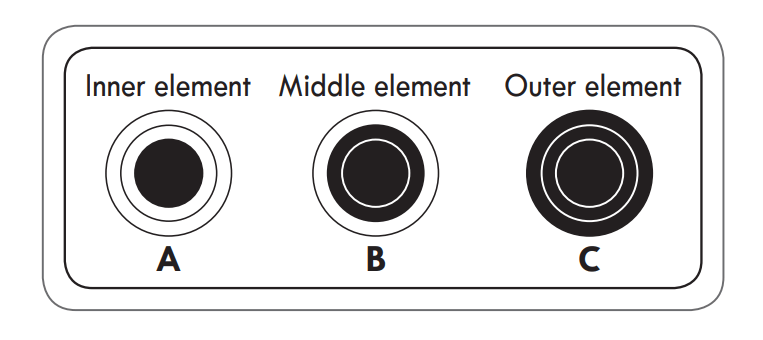
- Press the ON/OFF button that controls the triple element.
- Press the Size Select button to select inner, middle or outer element function. The triple element defaults to the inner element function. The light bars above the Size Select button indicate whether the element is adjusted for the inner, middle or outer element function. One bar will display for the inner element and two bars will display for the middle element. Three bars will display for the outer element.
- Press the + button once to adjust the element's temperature to Hi, or the – button once to adjust the element's temperature to Lo.
- Use the – / + buttons to adjust the element's temperature settings. The element's temperature settings are adjustable at all times.
- To turn off the element after cooking, press the ON/ OFF button once.
NOTE:
- Hi is the highest temperature available.
- Lo is the lowest temperature available.
- Press and hold the + or – buttons to quickly scroll through the temperature settings.
CAUTION:
- NEVER leave food on the cooktop unattended. Spillovers can cause smoke. Greasy spillovers may catch on fire.
- The oven surface element may appear to have cooled after it has been turned OFF. The element may still be hot and you could be burned if you touch the element before it has cooled sufficiently.
Turning On the Warm Zone
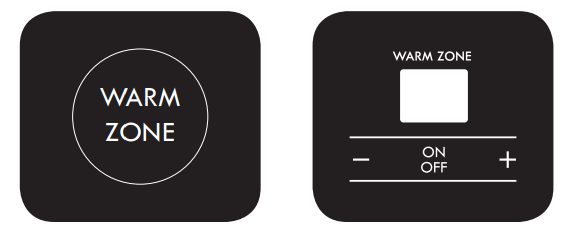
Use the Warm Zone to keep food warm after it has already been cooked. The warm zone is not meant for cooking food. Attempting to cook uncooked or cold food on the warm zone could result in a food-borne illness.
- Press the Warm Zone's ON/OFF button. The warm zone indicator light will flash.
- Press the + button once to set the temperature to Hi, or the – button once to set the temperature to Lo. The power level sequence is Lo, 2, 3, 4, Hi when using the – button, or the reverse when using the + button.
- Use the – / + buttons to adjust the temperature settings. The temperature settings are adjustable at all times.
- To turn off the warming zone, press the ON/OFF button once.
CAUTION:
- Only use cookware and dishes that are safe for oven and cooktop use.
- Always use oven mitts when removing food from the cooktop and oven.
- Do not place sealed containers on the cooktop.
- DO NOT use plastic wrap to cover food while on the cooktop. Plastic may melt onto the surface and be very difficult to clean.
- When using the warming zone, food should be kept in its container and covered with a lid or aluminum foil to maintain food quality.
- DO NOT leave food on the warming zone for more than two hours.
Recommended Settings
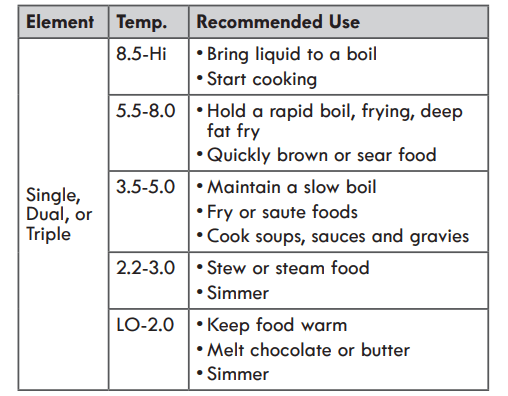
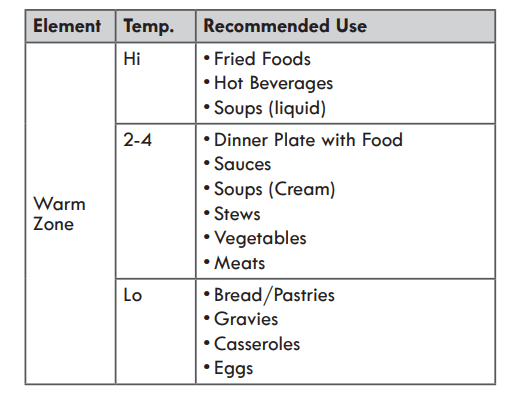
Home Canning Tips
Be sure that the canner is centered over the surface unit and is flat on the bottom.
- The base must not be more than 1 inch larger than the element. Use of water bath canners with rippled bottoms may extend the time required to bring the water to a boil and the cooktop may be damaged.
- Some canners are designed with smaller bases for use on smooth surfaces.
- Use the high heat setting only until the water comes to a boil or pressure is reached in the canner.
- Reduce to the lowest heat setting that maintains the boil, or pressure. If the heat is not turned down, the cooktop may be damaged
Using the Proper Cookware
Using the proper cookware can prevent many problems. Be sure to follow the cookware recommendations to reduce cooking times and heat food more evenly.
Checking Pans for Flat Bottoms
- Place a ruler across the bottom of the pan.
- Hold the ruler and pan up to the light.
- No light should be visible between the ruler and the pan.
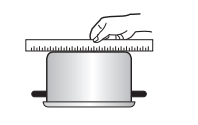
NOTE:
- Do not use pans smaller than 7" in diameter for the front surface units.
- Do not use a small pan on a large element. Not only does this waste energy, but it can also result in spillovers burning onto the cooking area.
- The bottom surfaces of cookware should be flat. Do not use cookware that is oversized or uneven such as rounded-bottom woks, cookware with a rippled bottom, or oversized canners and griddles.
- Do not use foil or foil-type containers. Foil may melt onto the glass. Do not use the cooktop if metal has melted on it. Call an authorized Kenmore Service Center.
| Recommended cookware | Do not use |
| Flat bottom and straight sides. | Pans with curved, grooved, or warped bottoms. Pans with uneven bottoms do not cook efficiently and sometimes may not boil liquid. |
| Heavy-gauge pans | Very thin-gauge metal or glass pans. |
| Pan sizes that match the amount of food to be prepared and the size of the surface element. | Pans that are smaller or larger than the element. |
| Weight of handle does not tilt pan. Pan is well balanced. | Cookware with loose or broken handles. Heavy handles that tilt the pan. |
| Tight-fitting lids. | Loose-fitting lids |
| Flat bottom woks. | Woks with a ring-stand bottom. |
USING THE OVEN
Before Using the Oven
NOTE:
- Because the oven temperature cycles, an oven thermometer placed in the oven cavity may not show the same temperature that is set on the oven.
- It is normal for the convection fan to run while preheating during a regular bake cycle.
- The convection fan motor may run periodically during a regular bake cycle.
Oven Vent
Areas near the vent may become hot during operation and may cause burns. Do not block the vent opening. Avoid placing plastics near the vent as heat may distort or melt the plastic.
It is normal for steam to be visible when cooking foods with high moisture content.
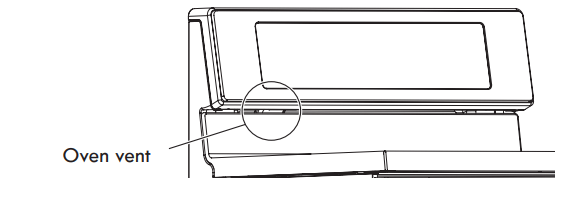
Using oven racks
The racks have a turned-up back edge that prevents the racks from being pulled out of the oven cavity.
Removing Racks
- Pull the rack straight out until it stops.
- Lift up the front of the rack and pull it out.
Replacing Racks
- Place the end of the rack on the support.
- Tilt the front end up and push the rack in.
CAUTION:
- Replace oven racks before turning the oven on to prevent burns.
- DO NOT cover the racks with aluminum foil, or any other material, or place anything on the bottom of the oven. Doing so will result in poor baking and may damage the oven bottom.
- Only arrange oven racks when the oven is cool.
Oven Controls
Sabbath Mode
SABBATH mode is typically used on the Jewish Sabbath and holidays. When the SABBATH mode is activated, the oven does not turn off until the SABBATH mode is deactivated. In SABBATH mode, all function buttons, except for the STOP button, are inactive. Sb will appear in both the cooktop and oven displays.
NOTE: If the oven light is turned ON and the SABBATH mode is active, the oven light will remain ON until the SABBATH mode is turned OFF. If the oven light needs to be OFF, be sure to turn the oven light OFF before activating the SABBATH mode. SABBATH mode can only be used while baking (BAKE mode).
Setting Sabbath Mode
- Press BAKE.
- Press the number buttons to enter the bake temperature.
- Press START.
- Press and hold the SETTINGS button for three seconds. Sb and
 will appear in the display when the Sabbath mode is activated.
will appear in the display when the Sabbath mode is activated. - To cancel the Sabbath mode, press and hold the SETTINGS button for three seconds. To cancel the Bake function, press STOP at any time.
Changing the Temperature while in SABBATH Mode
- Press BAKE. (No tones will sound and the display will not change.)
- Set the temperature using the number buttons.
- Press START.
NOTE: There is a 15-second delay before the oven will recognize the temperature change.
Bake
BAKE is used to prepare foods such as pastries, breads and casseroles. The oven can be programmed to bake at any temperature from 170°F (77°C) to 550°F (288°C). The default temperature is 350°F (177°C).
Setting the BAKE Function (example, 375°F):
- Press BAKE.
- Set the oven temperature using the number buttons: press 3, 7 and 5.
- Press START. The oven will start to preheat. As the oven preheats, the temperature is displayed and rises in 5-degree increments. Once the oven reaches the set temperature, a tone will sound and the oven light will flash on and off.
- When cooking is complete, press STOP.
- Remove food from the oven.
NOTE: It is normal for the convection fan to operate periodically throughout a normal bake cycle in the lower oven. This is to ensure even baking results.
Baking Tips
- Baking time and temperature will vary depending on the ingredients, size, and shape of the baking pan used.
- Check for food doneness at the minimum recipe time.
- Use metal bakeware (with or without a nonstick finish), heatproof glass-ceramic, ceramic or other bakeware recommended for oven use.
- Dark metal pans or nonstick coatings will cook food faster with more browning. Insulated bakeware will slightly lengthen the cooking time for most foods.
NOTE: The oven bottom has a porcelain-enamel finish. To make cleaning easier, protect the oven bottom from excessive spillovers by placing a cookie sheet on the rack below the rack you are cooking on. (Line the cookie sheet with parchment paper for easy cleanup.) This is particularly important when baking a fruit pie or other foods with a high acid content. Hot fruit fillings or other foods that are highly acidic may cause pitting and damage to the porcelain-enamel surface and should be wiped up immediately
Convection Bake
The convection system uses a fan to circulate the heat evenly within the oven. Improved heat distribution allows for even cooking and excellent results while cooking with single or multiple racks.
Setting the CONVECTION BAKE Function (example, 375°F):
- Press CONV. BAKE. The display will flash Conv Bake.
- Set the oven temperature using the number buttons: press 3, 7 and 5.
- Press START. The display will show CONV. BAKE and the oven temperature starting at 100°F. As the oven preheats, the display will show increasing temperatures in 5-degree increments. Once the oven reaches the set adjusted temperature, a tone will sound and the oven light will flash on and off. The display will show the auto converted oven temperature 350°F, CONV. BAKE and the fan icon.
- When cooking has finished or to cancel, press STOP.
NOTE: The oven fan will run while convection baking. The fan will stop when the door is open, but the heat will not turn off. In some cases, the fan may shut off during a convection bake cycle.
Tips for Convection Baking
- Cookies and biscuits should be baked on pans with no sides or very low sides to allow heated air to circulate around the food. Food baked on pans with a dark finish will cook faster.
- When using Convection Bake with a single rack, place oven rack in position C. If cooking on multiple racks, place the oven racks in positions B and D (for 2 racks).
- Multiple oven rack cooking may slightly increase cook times for some foods.
- Cakes, cookies and muffins will have better results when using multiple racks.
Convection Roast
The CONVECTION ROAST feature is designed to give optimum roasting performance. CONVECTION ROAST combines cooking with the convection fan to roast meats and poultry. The heated air circulates around the food from all sides, sealing in juices and flavors. Foods are crispy brown on the outside while staying moist on the inside. Convection roasting is especially good for large tender cuts of meat, uncovered.
Setting the CONVECTION ROAST Function (example, 375°F):
- Press CONV. ROAST. The display will flash Conv Roast.
- Set the oven temperature using the number buttons: press 3, 7 and 5.
- Press START. The display will show CONV. ROAST and the oven temperature starting at 100°F. As the oven preheats, the display will show increasing temperatures in 5-degree increments. Once the oven reaches the set adjusted temperature, a tone will sound and the oven light will flash on and off. The display will show the auto converted oven temperature 350°F, CONV. ROAST and the fan icon.
- When cooking has finished or to cancel, press STOP.
NOTE: The oven fan will run while convection roasting. The fan will stop when the door is open, but the heat will not turn off. In some cases, the fan may shut off during a convection roast cycle.
Convection Roast Guide
When preparing meats for convection roasting, use either a broiler pan and grid or a shallow pan with a roasting rack. A broiler pan will catch grease spills and the grid will help prevent grease splatters. A roasting rack will allow the heat to circulate around the meat.
- Place the oven rack in rack position A or B. See Rack Guides on next page for details.
- Place the cookware on the oven rack.
- Place the grid in the broiler pan or the roasting rack in the shallow pan.
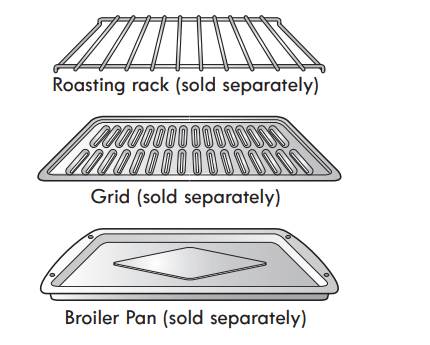
CAUTION:
- DO NOT use a roasting rack when broiling. This will help prevent food from coming in contact with the broil element and grease from splattering.
- DO NOT use the broiler pan without the grid.
- DO NOT cover the grid with aluminum foil.
- Position food fat side up on cookware.
Baking and Roasting Guide
Baking results will be better if baking pans are centered in the oven as much as possible. If cooking on multiple racks, place the oven racks in positions shown at right.
Rack and Pan Placement


Single Rack Baking Guide
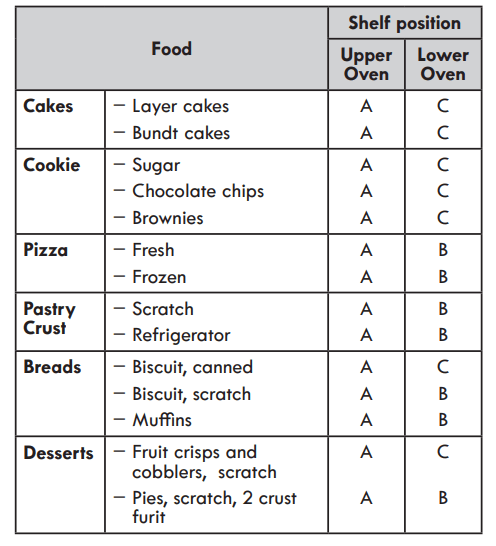
Single Rack Roasting Guide
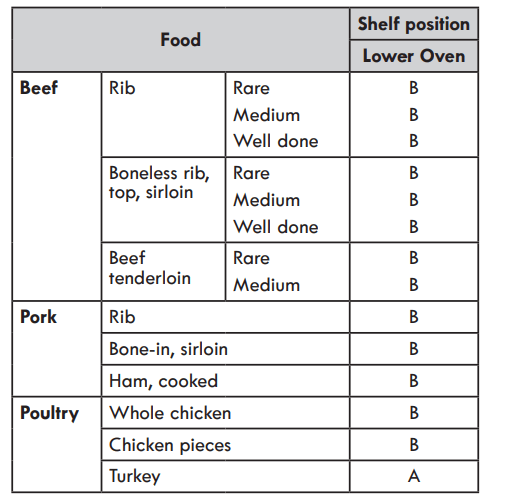
Broil
The Broil function uses intense heat from the upper heating element to cook food. BROIL works best for tender cuts of meat, fish, and thinly cut vegetables.
Some models may feature a hybrid broiler consisting of an inner broiler that utilizes a carbon heating element which provides instantaneous heat, and a traditional outer broiling element. During normal broiler operation, it is normal for either element to cycle off intermittently.
This range is designed for closed-door broiling. The door has a broil stop position.
CAUTION:
- DO NOT use a broiler pan without a grid. Oil can cause a grease fire.
- DO NOT cover the grid and broiler pan with aluminum foil. Doing so will cause a fire.
- Always use a broiler pan and grid for excess fat and grease drainage. This will help to reduce splatter, smoke, and flare-ups.
Speed Broil
The Speed Broil setting is designed to reduce the amount of time it takes to broil foods. By utilizing the infrared broil element, which provides heat instantaneously, there is no need for preheating.
Setting the Oven to BROIL / SPEED BROIL
- Open the oven door to the broil stop position (about 10 degrees from the closed position).
- Press the BROIL or SPEED BROIL button once for Hi or twice for Lo.
- Press the START button. The oven will begin to heat.
- If using Broil, it is best to let the oven preheat for approximately five minutes before cooking food.
- When cooking is complete, or to cancel at any time, press the STOP button.
Smoking
Due to the intense heat associated with broiling, it is normal to experience smoke during the cooking process. This smoke is a natural byproduct of searing and should not cause you to worry. If you are experiencing more smoke than you are comfortable with, use the following tips to reduce the amount of smoke in your oven.
- Always use a broiler pan. Do not use saute pans or regular baking sheets for safety reasons.
- NEVER use a broiler pan that is not thoroughly cleaned and at room temperature at the beginning of cooking.
- ALWAYS run your cooktop ventilation system or vent hood during broiling.
- Keep the interior of your oven as clean as possible. Leftover debris from prior meals can burn or catch fire.
- Avoid fatty marinades and sugary glazes. Both of these will increase the amount of smoke you experience. If you would like to use a glaze, apply it at the very end of cooking.
- If you are experiencing significant smoke with any food item, consider:
• Lowering the broiler to the LO setting.
• Lowering the rack position to cook the food further away from the broiler.
• Using the HI broil setting to achieve the level of searing you desire, and then either switching to the LO broil setting, or switching to the BAKE function. - As a rule, fattier cuts of meat and fish will produce more smoke than leaner items.
- Adhere to the recommended broil settings and cooking guidelines in the chart on the following page whenever possible.
Broiling Guide
The size, weight, thickness, starting temperature, and your preference of doneness will affect broiling times. This guide is based on meats at refrigerator temperature. For best results when broiling, use a pan designed for broiling (refer to Fig.1)
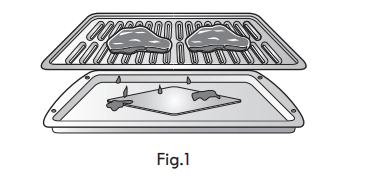
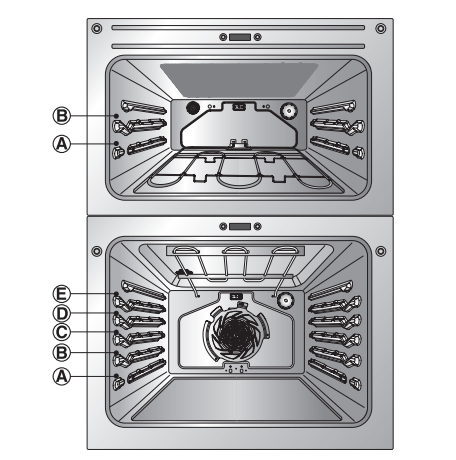
Broiling Chart
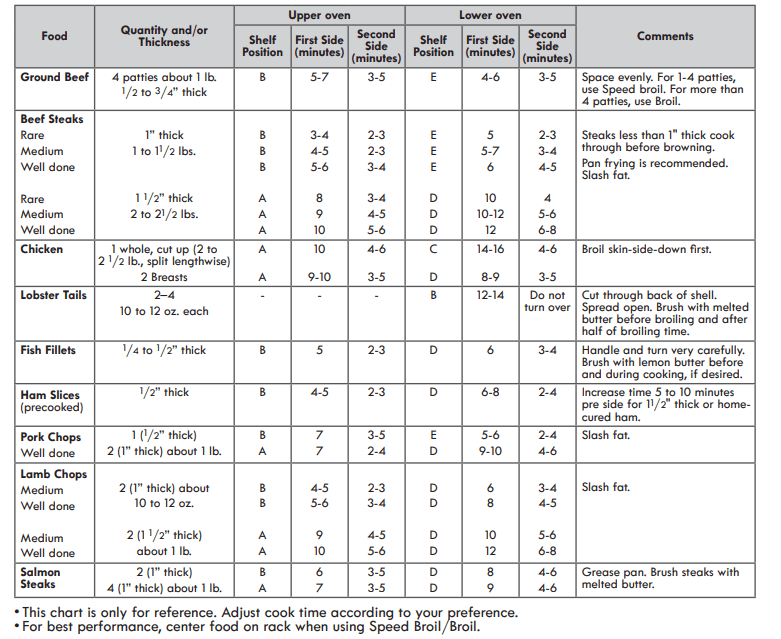
Broiling Tips
Beef
- Steaks and chops should always be allowed to rest for five minutes before cutting into them and eating. This allows the heat to distribute evenly through the food and creates a more tender and juicy result.
- Consider removing thick pieces of meat from the refrigerator 30 minutes prior to cooking. This will help them cook more quickly and evenly, and will produce less smoke when broiling. Please note that cooking times will likely be shorter than the times indicated in the Broiling Chart.
- For bone-in steaks or chops that have been Frenched (all meat removed from around the bone), wrap the exposed sections of bone in foil to reduce burning.
Seafood
- When broiling skin-on fish, always use the Medium broil setting and always broil the skin side last.
- Seafood is best consumed immediately after cooking. Allowing seafood to rest after cooking can cause the food to dry out.
- It is a good idea to rub a thin coating of oil on the surface of the broiling pan before cooking to reduce sticking, especially with fish and seafood. You can also use a light coating of non-stick pan spray.
Vegetables
- Toss your vegetables lightly in oil before cooking to improve browning.
Warm
This function will maintain an oven temperature of 170°F. The WARM function will keep cooked food warm for serving up to 3 hours after cooking has finished. The Warm function may be used without any other cooking operations or can be used after cooking has finished using TIMED BAKE or DELAYED TIMED BAKE.
Setting the WARM Fuction
- Press the WARM or WARM/PROOF button.
- Press START.
- Press the STOP button at any time to cancel.
Setting the WARM Function after a Timed Cook
- Select the cooking function.
- Enter the oven temperature using the number buttons.
- Press the COOK TIME button and enter the cook time using the number buttons.
- Press the WARM button.
- Press the START button.
- Press STOP any time after cooking has finished to cancel the WARM function.
NOTE: The WARM function is intended to keep food warm. Do not use it to cool food down.
Proof
This feature maintains a warm oven for rising yeast leavened products before baking.
Setting the PROOF Function
- Use rack position B or C for proofing.
- Press the WARM/PROOF button until PrF appears in the display.
- Press the START button.
- Press the STOP button when proofing is finished.
NOTE:
- To avoid lowering the oven temperature and lengthening proofing time, do not open the oven door unnecessarily. Check bread products early to avoid overproofing.
- Do not use the proofing mode for warming food or keeping food hot. The proofing oven temperature is not hot enough to keep foods at safe temperatures. Use the WARM feature to keep food warm. Proofing will not operate when the oven is above 125 °F. HOT will show in the display
CARE AND CLEANING
Cleaning the Glass/Ceramic Cooktop
CAUTION:
- DO NOT use scrub pads or abrasive cleaning pads. They may damage the cooktop surface.
- For your safety, wear an oven mitt or potholder while cleaning the hot cooking surface.
Use ceramic cooktop cleaner on the glass cooktop. Other creams may not be as effective or may scratch, damage or stain the cooktop surface.
To maintain and protect the surface of the glass cooktop, follow these steps:
- Before using the cooktop for the first time, clean it with a ceramic cooktop cleaner. This helps protect the top and makes cleanup easier.
- Daily use of ceramic cooktop cleaner will help keep the cooktop looking new.
- Shake the cleaning cream well. Apply a few drops of cleaner directly to the cooktop.
- Use a paper towel to clean the entire cooktop surface.
- Rinse with clear water and use a dry cloth or paper towel to remove all cleaning residue.
NOTE: DO NOT heat the cooktop until it has been cleaned thoroughly.
IMPORTANT:
Spilled sugar or sugary foods, or melted plastic or foil on the cooktop can damage the glass ceramic surface. Use a metal razor scraper to remove these materials IMMEDIATELY while the cooking surface is still hot. For your safety, use an oven mitt or potholder while cleaning the hot cooking surface.
- Foods with a high sugar content include preserves, ketchup, tomato sauce, jellies, fudge, candy, syrups, and chocolate.
Burned-on Residue
- While the cooktop is still hot, remove any burnt-on deposits or spilled food from the glass/ceramic cooking surface with a suitable metal razor scraper (similar to scraping paint off of a windowpane - it will not damage the decorated cooking surface). Hold the scraper at an approximately a 30° angle to the cooktop.
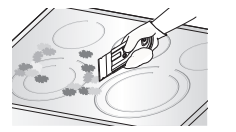
See other models: 49529 74133 40289 32602 42569
NOTE:
•Do not use a dull or nicked blade.
• To prevent burns, wear an oven mitt or potholder while using the metal scraper. - When the cooking surface has cooled down, apply a few dabs (about the size of a dime) of an approved cleaner in each burner area and work the cleaning cream over the cooktop surface with a damp paper towel.
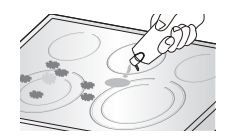
- Clean with clear water and wipe the cooktop surface with a clean, dry paper towel.
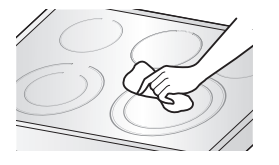
Metal Marks and Scratches
- Do not slide pots and pans across the cooktop. Doing so will leave metal markings on the cooktop surface. To help remove these marks, use a ceramic cooktop cleaner with a cleaning pad for ceramic cooktops.
- If pots with a thin overlay of aluminum or copper are allowed to boil dry, the overlay may leave a black discoloration on the cooktop. This should be removed immediately before heating again or the discoloration may become permanent.
CAUTION:
Cookware with rough or uneven bottoms can mark or scratch the cooktop surface.
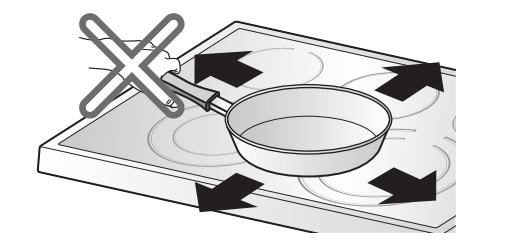
- Do not slide metal or glass across the cooktop surface.
- Do not use cookware with any dirt buildup on bottom.
Self Clean
The Self Clean cycle uses extremely hot temperatures to clean the oven cavity. While running the Self Clean cycle, you may notice smoking or an odor. This is normal; especially if the oven is heavily soiled.
During Self Clean, the kitchen should be well ventilated to minimize the odors from cleaning.
Before Starting Self Clean
- Remove the oven racks, broiler pan, broiler grid, all cookware, aluminum foil or any other material from the oven.
- The kitchen should be well ventilated to minimize the odors from cleaning.
- Wipe any heavy spillovers on the bottom of the oven.
- Make sure that the oven light bulb cover is in place and the oven light is off.
- The oven light cannot be turned on during a self clean cycle. The oven light cannot be turned on until the oven temperature has cooled below 500 ˚F (260 ˚C) after a Self Clean cycle is complete.
CAUTION:
- DO NOT leave small children unattended near the appliance. During the Self Clean cycle, the outside of the range can become very hot to touch.
- If you have pet birds, move them to another well ventilated room. The health of some birds is extremely sensitive to the fumes given off during the Self Clean cycle of any range.
- DO NOT line the oven walls, racks, bottom or any other part of the range with aluminum foil or any other material. Doing so will destroy heat distribution, produce poor baking results and cause permanent damage to the oven interior (aluminum foil will melt to the interior surface of the oven).
- DO NOT force the door open. This can damage the automatic door locking system. Use care when opening the oven door after the Self Clean cycle. Stand to the side of the oven when opening the door to allow hot air or steam to escape. The oven may still be VERY HOT.
During the Self Clean cycle, the cooktop elements and warming drawer cannot be used.
NOTE:
- Remove oven racks and accessories before starting the Self Clean cycle.
- If oven racks are left in the oven cavity during the Self Clean cycle, they will discolor and become difficult to slide in and out.
- Clean the frame of the oven and door with hot soapy water. Rinse well.
- Do not clean the gasket. The fiberglass material of the oven door gasket cannot withstand abrasion. It is essential for the gasket to remain intact. If you notice it becoming worn or frayed, replace it.
- Wipe up any heavy spillovers on the oven bottom.
- Make sure that the oven light bulb cover is in place and the oven light is off.
Setting Self Clean
The Self Clean function has cycle times of 3, 4, or 5 hours.
Self Clean Soil Guide

- Remove all racks and accessories from the oven.
- Press the SELF CLEAN button. The oven defaults to the recommended four-hour self clean for a moderately soiled oven. Press twice for a five-hour self clean or three times for a three-hour self clean.
- Press START.
- Once the Self Clean is set, the oven door will lock automatically and the lock icon will display. You will not be able to open the oven door until the oven has cooled. The lock will release automatically when the oven has cooled.
CAUTION:
DO NOT force the oven door open when the lock icon is displayed. The oven door will remain locked until the oven temperature has cooled. Forcing the door open will damage the door.
Setting Self Clean with a Delayed Start
- Remove all racks and accessories from the oven.
- Press the SELF CLEAN button. The oven defaults to the recommended four-hour self clean for a moderately soiled oven. Press twice for a five-hour self clean or three times for a three-hour self clean.
- Press the DELAY START button.
- Use the number buttons to enter the time of day you would like the Self Clean to start.
- Press the START button.
NOTE: It may become necessary to cancel or interrupt a Self Clean cycle due to excessive smoke or fire in the oven. To cancel the Self Clean function, press the STOP button.
During Self Clean
- The Self Clean cycle uses extremely hot temperatures to clean the oven cavity. While running the Self Clean cycle, you may notice smoking or an odor. This is normal, especially if the oven is heavily soiled.
- As the oven heats, you may hear sounds of metal parts expanding and contracting. This is normal and will not damage the oven.
- Do not force the oven door open when LOCKED is displayed. The oven door will remain locked until the oven temperature has cooled. Forcing the door open will damage the door.
NOTE:
- The Self Clean cycle cannot be started if the Lockout feature is active.
- Once the Self Clean cycle is set, the oven door will lock automatically. You will not be able to open the oven door until the oven is cooled. The lock will release automatically.
- Once the door has been locked, the LOCKED indicator light will stop flashing and remain on. Allow about 15 seconds for the oven door lock to activate.
- If the clock is set for a 12 hour display (default) the Delayed Self Clean can never be set to start more than 12 hours in advance.
After the Self Clean Cycle
- The oven door will remain locked until the oven temperature has cooled.
- You may notice some white ash in the oven. Wipe it off with a damp cloth or a soap-filled steel wool pad after the oven cools. If the oven is not clean after one cleaning cycle, repeat the cycle.
- If oven racks were left in the oven and do not slide smoothly after a cleaning cycle, wipe racks and rack supports with a small amount of vegetable oil to make them glide more easily.
- Fine lines may appear in the porcelain because it went through heating and cooling. This is normal and will not affect performance.
Lo Temp Clean
Lo Temp Clean enamel technology gives you two cleaning options for the inside of the range. The Lo Temp Clean feature takes advantage of this new enamel to help lift soils without harsh chemicals, and it runs using ONLY WATER for just 20 minutes in low temperatures to help loosen LIGHT soils before handcleaning.
While Lo Temp Clean is quick and effective for small and LIGHT soils, the Self Clean feature can be used to remove HEAVY, built-up soils. The intensity and high heat of the Self Clean cycle may result in smoke which will require the opening up of windows to provide ventilation. Compared to the more intense Self Clean process, the oven gives you the option of cleaning with LESS HEAT, LESS TIME, and virtually NO SMOKE OR FUMES.
When needed, the range still provides the Self Clean option for longer, more thorough oven cleaning for heavier, built up soils.
BENEFITS OF Lo Temp Clean
- Helps loosen light soils before hand-cleaning
- Lo Temp Clean only uses water; no chemical cleaners
- Makes for a better Self Clean experience
− Delays the need for a Self Clean cycle
− Minimizes smoke and odors
− Can allow shorter Self Clean time
WHEN TO USE Lo Temp Clean

CLEANING TIPS
- Allow the oven to cool to room temperature before using the Lo Temp Clean cycle. If your oven cavity is above 150°F (65°C), “OVEN IS HOT- - PLEASE WAIT” will appear in the display, and the Lo Temp Clean cycle will not be activated until the oven cavity cools down.
- A plastic spatula can be used as a scraper to scrape off any chunks or debris before and during oven cleaning.
- Using the rough side of a non-scratch scouring pad may help to take off burnt-on stains better than a soft sponge or towel.
- Certain non-scratch scrubbing sponges, such as those made of melamine foam, available at your local stores, can also help improve cleaning.
- The range should be level to ensure that the bottom surface of the oven cavity is entirely covered by water at the beginning of the Lo Temp Clean cycle.
- For best results, use distilled or filtered water. Tap water may leave mineral deposits on the oven bottom.
- Soil baked on through several cooking cycles will be more difficult to remove with the Lo Temp Clean cycle.
- Do not open the oven door during the Lo Temp Clean cycle. Water will not get hot enough if the door is opened during the cycle.
- For hard to reach areas such as the back surface of the lower oven, it is better to use the Self Clean cycle.
Lo Temp Clean INSTRUCTION GUIDE
- Remove oven racks and accessories from the oven.
- Scrape off and remove any burnt-on debris with a plastic scraper. Suggested plastic scrapers:
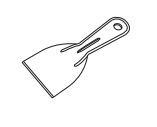
•Hard plastic spatula
• Plastic pan scraper
• Plastic paint scraper •Old credit card - Fill a spray bottle with 1¼ cups (10 oz or 300 ml) of water and use the spray bottle to thoroughly spray the inside surfaces of the oven.
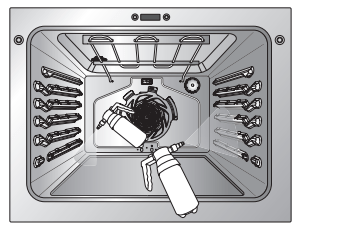
- Use at least ¼ cup (2 oz or 50 ml) of the water to completely saturate the soil on both the walls and in the corners of the oven.
- Spray or pour the remaining 1 cup (8 oz or 250 ml) of water onto the bottom center of the oven cavity. The indentation on the oven bottom should be fully covered to submerge all soils. Add water if necessary.
NOTE: Use the "mist" setting on the spray bottle for better coverage. The entire 1¼ cup (10 oz or 300 ml) of water should be used for each oven cavity cleaned. Do not spray water directly on the door. Doing so will result in water dripping to the floor. - Close the oven door.
Press the Lo Temp Clean button. Press the START button.
CAUTION:
- Some surfaces may be hot after the Lo Temp Clean cycle. Wear rubber gloves while cleaning to prevent burns.
- During the Lo Temp Clean cycle, the oven becomes hot enough to cause burns. Wait until the cycle is over before wiping the inside surface of the oven. Failure to do so may result in burns.
- Avoid leaning or resting on the oven door glass while cleaning the oven cavity - A tone will sound at the end of the 20-minute cycle. Press the STOP button to clear the display and end the tone.
- After the cleaning cycle and during hand-cleaning, enough water should remain on the oven bottom to completely submerge all soils. Add water if necessary. Place a towel on the floor in front of the oven to capture any water that may spill out during hand-cleaning. If you are cleaning the upper oven on a double oven range, cover the holes in the top of the lower oven door with a towel to capture any water that may drip into the door during hand cleaning.
- Clean the oven cavity immediately after the Lo Temp Clean cycle by scrubbing with a wet, nonscratch scouring sponge or pad. (The scouring side will not scratch the finish.) Some water may spill into the bottom vents while cleaning, but it will be captured in a pan under the oven cavity and will not hurt the burner.
NOTE: DO NOT use any steel scouring pads, abrasive pads or cleaners as these materials can permanently damage the oven surface.
- Once the oven cavity is cleaned, wipe up any excess water with a clean, dry towel. Replace racks and any other accessories.
- If some light soils remain, repeat the above steps, making sure to thoroughly soak the soiled areas. If stubborn soils remain after multiple Lo Temp Clean cycles, run the Self Clean cycle. Be sure that the oven cavity is empty of oven racks and other accessories, and that the oven cavity surface is dry before running the Self Clean cycle. Consult the Self Clean section of your owner’s manual for further details.
NOTE:
• If you forget to saturate the inside of the oven with water before starting Lo Temp Clean, press the STOP button to end the cycle. Wait for the range to cool to room temperature and then spray or pour water into the oven and start another Lo Temp Clean cycle.
• The cavity gasket may be wet when the Lo Temp Clean cycle finishes. This is normal. Do not clean the gasket.
• If mineral deposits remain on the oven bottom after cleaning, use a cloth or sponge soaked in vinegar to remove them.
Cleaning the Exterior
Painted and Decorative Trim
For general cleaning, use a cloth with hot soapy water. For more difficult soils and built-up grease, apply a liquid detergent directly onto the soil. Leave it on for 30 to 60 minutes. Rinse with a damp cloth and dry. Do not use abrasive cleaners.
Stainless Steel Surfaces
To avoid scratches, do not use steel wool pads.
- Place a small amount of stainless steel appliance cleaner or polish on a damp cloth or paper towel.
- Clean a small area, rubbing with the grain of the stainless steel if applicable.
- Dry and buff with a clean, dry paper towel or soft cloth.
- Repeat as necessary.
Oven Door
- Use soapy water to thoroughly clean the oven door. Rinse well. DO NOT immerse the door in water.
- You may use a glass cleaner on the outside glass of the oven door. DO NOT spray water or glass cleaner on the door vents.
- DO NOT use oven cleaners, cleaning powders, or harsh abrasive cleaning materials on the outside of the oven door.
- DO NOT clean the oven door gasket. The oven door gasket is made of a woven material that is essential for a good seal. Care should be taken not to rub, damage, or remove this gasket.
CAUTION: Do not use harsh cleaners or harsh abrasive cleaning materials on the outside of the oven door. Doing so can cause damage.
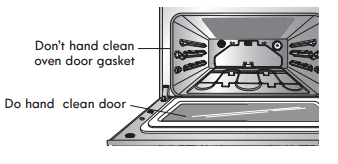
Broiler Pan and Grid

- Do not store a soiled broiler pan or grid anywhere in the range.
- Do not clean a broiler pan or grid in the self cleaning mode.
- Remove the grid from the pan. Carefully pour out the grease from the pan into a proper container.
- Wash and rinse the broiler pan and grid in hot water with a soap-filled or plastic scouring pad. •If food has burned on, sprinkle the grid with cleaner while hot and cover with wet paper towels or a dishcloth. Soaking the pan will remove burned-on foods.
- Both the broiler pan and grid may be cleaned with a commercial oven cleaner or in the dishwasher.
Replacing the Oven Light
The oven light is a standard 40-watt appliance bulb. It will turn on when the oven door is open. When the oven door is closed, press the  button to turn it on or off.
button to turn it on or off.
- Unplug the range or disconnect power and wait for the oven and bulb to cool.
- Turn the glass bulb cover in the back of the oven counter-clockwise to remove it.
- Turn the bulb counter-clockwise to remove it from the socket.
- Insert the new bulb and turn it clockwise.
- Insert the glass bulb cover and turn it clockwise.
- Plug in the range or reconnect the power.

WARNING:
- Make sure that the oven and bulb are cool.
- Disconnect the electrical power to the range at the main fuse or circuit breaker panel. Failure to do so can result in severe personal injury, death, or electrical shock.
Removing & Replacing the Lift- Off Oven Door
CAUTION:
- Be careful when removing and lifting the door.
- DO NOT lift the door by the handle.
− The door is very heavy.
UPPER OVEN
Removing the Door
- Fully open the door.
- Lift up and rotate the hinge locks toward the oven frame until they stop.
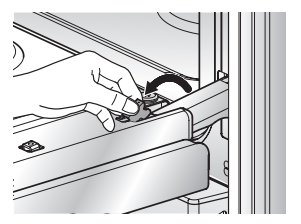
- Close the door to 30 degrees (you will feel the door stop). The hinge locks will contact the oven frame.
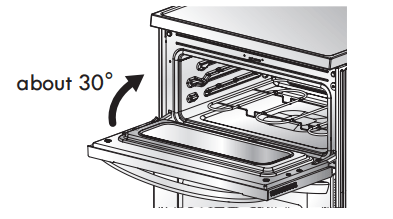
- On both sides of the door, press down on the release buttons on each hinge
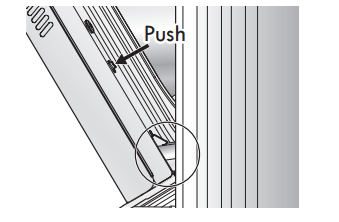
- Insert the glass bulb cover and turn it clockwise.
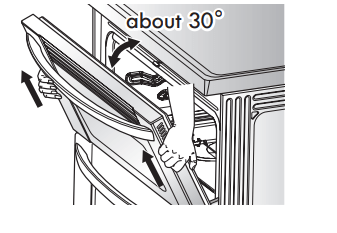
Replacing the Door
- Be sure both hinges are in a 30 degree position.
- Slide the door back onto the hinges until you hear a solid click and the release buttons have engaged.

- Fully open the door.
- Push the hinge locks down onto the hinges.
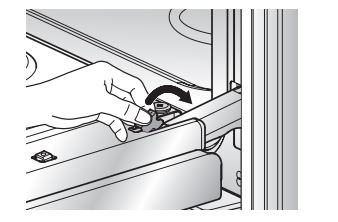
- Close the oven door.
LOWER OVEN
Removing the Door
- Fully open the door.
- Unlock the hinge locks, rotating them as far toward the open door frame as they will go.
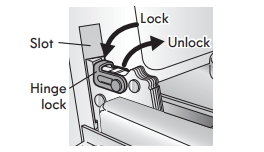
- Firmly grasp both sides of the door at the top.
- Close the door to the removal position (approximately five degrees) which is halfway between the broil stop position and fully closed. If the position is correct, the hinge arms will move freely.
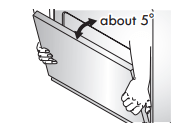
- Lift door up and out until the hinge arms are clear of the slots.
Replacing the Door
- Firmly grasp both sides of the door at the top.
- With the door at the same angle as the removal position, seat the indentation of the hinge arms into the bottom edge of the hinge slots. The notch in the hinge arms must be fully seated into the bottom edge of the slots.

- Open the door fully. If the door will not open fully, the indentation is not seated correctly in the bottom edge of the slots.
- Lock the hinge locks, rotating them back toward the slots in the oven frame until they lock.
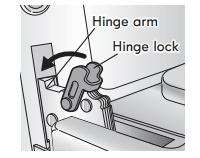
- Close the oven door.
Door Care Instructions
- Most oven doors contain glass that can break.
CAUTION:
- Do not close the oven door until all the oven racks are fully in place.
- Do not hit the glass with pots, pans, or any other object.
- Scratching, hitting, jarring, or stressing the glass may weaken its structure causing an increased risk of breakage at a later time.
TROUBLESHOOTING
BEFORE CALLING FOR SERVICE
Before you call for service, review this list. It may save you time and expense. The list includes common occurrences that are not the result of defective workmanship or materials in this appliance.
| Problem | Possible Causes / Solutions |
| Range is not level. |
|
| Cannot move appliance easily. Appliance must be accessible for service. |
|
| Oven control beeps and displays any F code error. |
|
| Surface units will not maintain a rolling boil or cooking is not fast enough |
|
| Surface units do not work properly |
|
| Surface unit stops glowing when changed to a lower setting |
|
| Areas of discoloration on the cooktop |
|
| Frequent cycling on and off of surface units |
|
| Oven will not work |
|
| Steam is exhausted through the oven vent. |
|
| Appliance does not operate. |
|
| Oven light does not work. |
|
| Oven smokes excessively during broiling. |
|
| Food does not bake or roast properly |
|
| Food does not broil properly |
|
| Food does not broil properly |
|
| Oven temperature too hot or too cold |
|
| Scratches or abrasions on cooktop surface |
|
| Metal marks |
|
| Brown streaks or specks |
|
| Areas of discoloration on cooktop |
|
| Oven will not self clean |
|
| “Crackling” or “popping” sound |
|
| Fan noise |
|
| Oven racks are difficult to slide |
|
| Convection Fan stops |
|
| Displayed Time is flashing |
|
| Excessive smoking during a self clean cycle |
|
| Oven door does not open after a self clean cycle |
|
| The oven does not clean after a self clean cycle |
|
| CLEAN and door flash in the display |
|
| LOCKED is on in the display when you want to cook |
|
| Burning or oily odor emitting from the vent |
|
| Oven racks are difficult to slide |
|
| Oven door will unlock after selfclean cycle |
|
| Moisture collects on oven window or steam comes from oven vent. |
|
FAQs
What types of cookware are recommended for use with my cooktop?
- The pans must have a flat bottom and straight sides.
- Only use heavy-gauge pans.
- The pan size must match the amount of food to be prepared and the size of the surface element.
- Use tight fitting lids.
- Only use flat-bottom woks.
Why does “HS” appear on the cooktop display?
HS (Hot Surface) will appear in the display once the element is turned off or during the self clean cycle. The HS indicator will stay on until the surface has cooled to approximately 150°F (66°C) or when the self clean cycle ends.
Why do the heating elements appear to be turning ON and OFF during use of the cooktop or oven?
Depending on your cooktop element setting or the temperature selected in your oven it is a NORMAL operation of the cooking elements to cycle on and off. This is NORMAL operation.
My new oven doesn’t cook like my old one. Is there something wrong with the temperature settings?
No, Your oven has been factory tested and calibrated. For the first few uses, follow your recipe times and temperatures carefully. If you still think your new oven is too hot or too cold, you can adjust the oven temperature yourself to meet your specific cooking needs. Refer to the “Oven Temperature Adjustment” section in this manual for easy instructions on how to adjust your thermostat.
Is it normal to hear a clicking noise coming from the back of my oven when I am using it?
Your new range is designed to maintain a tighter control over your oven’s temperature. You may hear your oven’s heating elements “click” on and off more frequently on your new oven. This is a NORMAL operation.
Why is the time flashing?
This means that the product has just been plugged in, or that it has experienced a power interruption. To clear the flashing time, press any button and reset the clock if needed.
During convection cooking the fan stops when I open the door. Is that normal?
Yes, this is normal. When the door is opened, the convection fan will stop until the door is closed.
Can I use aluminum foil to catch drippings in my oven cavity?
No. If aluminum foil is placed on the bottom of the oven cavity, it will burn and you will not be able to remove it. The heater for the oven is below the oven cavity and provides direct heat to the bottom of the cavity. If you already have burnt foil on the bottom, do not worry, as it will not hinder the performance.
Can I use aluminum foil on the racks?
It is not recommended to place aluminum foil inside the oven cavity. Using foil on the racks will restrict airflow which could lead to poor cooking results.
Can I leave my racks in the oven when running a Self Clean cycle?
No. Although it will not damage the racks, it will discolor them and may make them hard to slide in and out during use. Remove all items from the oven before starting a Self Clean cycle.
What should I do if my racks are sticky and have become hard to slide in and out?
Over time, the racks may become hard to slide in and out. Apply a small amount of olive oil to the ends of the racks. This will work as a lubricant for easier gliding.
What should I do for hard to remove stains on my cooktop?
The cooktop should be cleaned after every use to prevent permanent staining. When cooking foods with high sugar content, such as tomato sauce, is it recommended to clean the stain while the cooktop is still warm. Use an oven mitt when cleaning to prevent burns. Refer to the CARE AND CLEANING section of this owner's manual for further instruction
Should I broil with the door open or closed?
Your electric range is designed for open-door broiling. The door has a broil stop position. The broil stop position is about 10 degrees from the closed position.
Why aren't the function buttons working?
Make sure that the range is not in Lockout mode. The lock symbol will show in the display if Lockout is activated. To deactivate Lockout, press and hold the START button for three seconds. The unlock melody will sound and UNLOCKING will appear in the display until the controls are unlocked.
My range is still dirty after running the Lo Temp Clean cycle. What else should I do?
The Lo Temp Clean cycle only helps to loosen light soils in your oven range to assist in hand-cleaning of your oven. It does not automatically remove all soils after the cycle. Some scrubbing of your oven range is required after running the Lo Temp Clean cycle.
I tried scrubbing my oven after running Lo Temp Clean, but some soils still remain. What can I do?
The Lo Temp Clean feature works best when the soils are fully soaked and submerged in water before running the cycle and during hand-cleaning. If soils are not sufficiently soaked in water, it can negatively affect the cleaning performance. Repeat the Lo Temp Clean process using sufficient water. Sugar-based and certain greasy soils are especially hard to clean. If some stubborn soils remain, use the Self Clean feature to thoroughly clean your oven.
Soils on my oven walls are not coming off. How can I get my walls clean?
Soils on the side and rear walls of your oven range may be more difficult to fully soak with water. Try repeating the Lo Temp Clean process with more than the ¼ cup (2 oz or 50 ml) spray recommended.
Will Lo Temp Clean get all of the soils and stains out completely?
It depends on the soil type. Sugar-based and certain grease stains are especially hard to clean. Also, if stains are not sufficiently soaked in water, this can negatively affect cleaning performance. If stubborn or built-up stains remain, use the Self Clean feature. Refer to the Self Clean section of your owner's manual.
Are there any tricks to getting some of the stubborn soils out?
Scraping the soils with a plastic scraper before and during hand-cleaning is recommended. Fully saturating soils with water is also recommended. However, certain types of soils are harder to clean than others. For these stubborn soils, the Self Clean cycle is recommended. Consult the Self Clean section of your owner's manual for details.
Is it safe for my convection fan, broil burner or heater element to get wet during Lo Temp Clean?
Yes. The convection fan, broiler burner or heater element may get a little wet during cleaning. However, direct spray onto the broil burner and heater elements is not necessary because these are self-cleaning during regular use.
Do I need to use all 1-1/4 cups (10 oz or 300 ml) of water for Lo Temp Clean?
Yes. It is highly recommended that 1 cup (8 oz or 250 ml) of water be sprayed or poured on the bottom and an additional 1/4cup (2 oz or 50 ml) of water be sprayed on walls and other soiled areas to fully saturate the soils for better cleaning performance.
I see “smoke” coming out of my oven range’s cooktop vents during Lo Temp Clean. Is this normal?
This is normal. This is not “smoke.” It is actually water vapor (steam) from the water in the oven cavity. As the oven heats briefly during Lo Temp Clean, the water in the cavity evaporates and escapes through the oven vents.
How often should I use Lo Temp Clean?
Lo Temp Clean can be performed as often as you wish. Lo Temp Clean works best when your oven is LIGHTLY soiled from such things as LIGHT grease splatter and small drops of cheese. Please refer to the Lo Temp Clean section in your owner's manual for more information.
What is required for Lo Temp Clean?
A spray bottle filled with 1¼ cups (10 oz or 300 ml) of water, a plastic scraper, a nonscratch scrubbing pad and a towel. You should not use abrasive scrubbers such as heavy-duty scouring pads or steel wool. Except for a towel, all of the materials you need are included in a special cleaning kit with your new range.
Can I run the Lo Temp Clean cycle on both of my ovens at once?
Yes. You can run the Lo Temp Clean cycle on both ovens at the same time. Some oven surfaces will be hot after the cycle completes running. Avoid leaning or resting on the oven door glass while cleaning the oven cavities. You can not run the Self Clean cycle on both ovens at the same time.
